|
Yellow
FeverYellow
FeverYellow
Fever |
|
... the
Plague of Memphis |
| |
| |
|
During the 1800's Memphis was a very swampy area
and was well known as the filthiest and most foul smelling
city on earth. Open sewers contributed to the
unpleasant odor and they provided breeding grounds for mosquitoes. Because
it wasn't known at the time that mosquitoes spread disease, nothing
was done to improve the situation for almost 40 years.
In addition the sewer smell was enhanced by another
smell due to Memphis paving the streets with "Nicholson
Pavement" - which was wooden blocks impregnated with
creosote. These blocks had begun to decay
and send forth a poisonous smell. Plus the soil
all around was reeking with
the excrements of ten thousand families. And the
city had
no organized service to carry garbage away. It was
one filthy city with a terrible smell - and the perfect
breeding ground for
YELLOW FEVER.
|
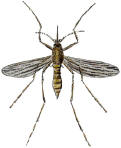 |
|
| |
|
Yellow Fever originally hit the United States in 1668-69
in the New York-Philadelphia area. It didn't
make its way south until 1828, when it first appeared in
New Orleans. Within days, it moved up-river and found
the perfect breeding ground - swampy and filthy Memphis.
During it's first epidemic in 1828, there
were 650 cases and 150 deaths. Consider that the
population was under 1,000 at that time and you get an
idea of how deadly this disease was. |
| |
| |
Memphis had six
major Yellow Fever epidemics
|
1828 |
First Yellow Fever
epidemic |
650 Cases |
150 Deaths |
| |
|
|
|
|
1855 |
Second Yellow
Fever epidemic |
1250 Cases |
220 Deaths |
| |
|
|
|
|
1867
|
Third Yellow Fever
epidemic |
2500 Cases |
550 Deaths |
| |
|
|
|
|
1873 |
Fourth Yellow
Fever epidemic |
5000 Cases |
2000 Deaths |
| |
|
|
|
|
1878 |
Fifth Yellow Fever
epidemic |
17000 Cases |
5000 + Deaths |
| |
|
|
|
|
1879 |
Sixth Yellow Fever
epidemic |
2000 Cases |
600 Deaths |
| |
|
|
|
|
|
|
|
|
|
|
|
|
Click on small photos to
enlarge them. |
|
|
|
|
|
 |
Yellow
Fever had originally come from West Africa and may have been
brought to the United States on Slave Ships. The disease
requires warm weather to survive and thrives in wet and hot
summers where mosquitoes can breed prodigiously. There
seemed to be no rhyme or reason to who fell ill. Once
infected the victim developed a piercing headache, then a
chill, and then a temperature. The pain could be so
intense that victims sometimes became demonic and ran through
the streets screaming and thrashing. Internal bleeding
would develop which produced the trademark black vomit,
composed of blood and stomach acids. The liver and
kidneys failed and the victim turned yellow and soon died,
usually within 2 weeks. Some who survived had bodies and
minds permanently crippled. |
|
|
|
|
|
|
|
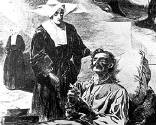 |
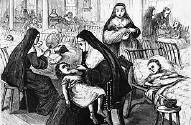 |
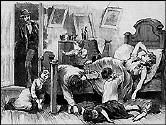 |
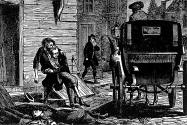 |
|
Nuns
care for the ill |
Nuns care for the ill |
The dead and the dying... |
Pick up the dead... |
|
|
|
|
|
|
Memphis
had been exposed to Yellow Fever in 1828, 1855, and 1867 and each
time it was brought north by steamer from New Orleans.
In 1867 it was quite severe although it was confined to the section
of the city where it had developed. But nothing prepared the
city for the devastation the fever brought in the 1870s. In
August of 1873 it came again. Two boats had arrived from New
Orleans, each with a sick man on board. These men were put off
at a low, marshy area known as "Happy Hollow" not far from the Navy
Yard. One died before he could be taken to the hospital and
the other shortly after reaching it. The attending physicians
suspected Yellow Fever, but kept it to themselves. Suddenly
several deaths on Promenade Street were announced and it was now
official. The authorities tried to cleanse and disinfect the
city, but it was too late. The deaths grew daily. Tens
of thousands of people fled. The streets were deserted except
for the funeral trains. Catholic and Protestant clergymen and
physicians ran untold risks, and men and women freely gave their
lives in the service of others. 2500 people died between
August and November. As usual, the first frost ended the
plague, but they didn't know why. |
|
|
|
|
 |
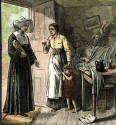 |
 |
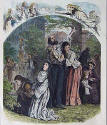 |
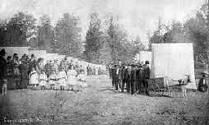 |
|
Doctor Calls |
Nun Calls |
Harpers |
Welcome Frost... |
Internment Camp |
|
|
|
|
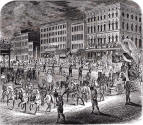 |
<
And the onslaught of Yellow Fever didn't prevent
Memphis from holding its 1873 annual carnival with the
gorgeous pageants. At the time, the 2500 deaths
constituted the most Yellow Fever victims in an inland city -
ever. |
|
|
|
|
|
|
|
|
The Great Yellow Fever Epidemic of
1878
Yellow
Fever returned to Memphis with a vengeance in 1878. There had been a mild
winter, a long spring, and a torrid summer. By July New
Orleans had reported an epidemic of the fever. Memphis immediately threw up
checkpoints at major points of entry into the city. 25,000 Memphians fled the city, and of those left, 17,000 caught the
fever and 5,150 of those died.
|
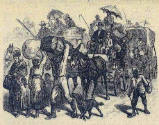 |
| |
25,000
Evacuate |
|
|
|
|
In 1878 William Warren, a deckhand,
entered Memphis from President's Island. Two days later
he was dead. Several days later, New Orleans verified
that Yellow Fever was present, and Warren had come from that
city. Those who could afford to leave the city immediately
left. In July the city had a population of 47,000. Over
25,000 evacuated. Quarantine facilities were set up in
Germantown and the main facility on President's Island.
Passenger ships were blocked from the harbor. Schools were
converted to hospitals. Refugee Camps were set up. Of
the 19,000 people who remained in Memphis, 17,000 contracted Yellow Fever.
Of the 41 police officers, only 7 were fit for duty. One by
one, they fell, dying at their posts. Food and fuel became
scarce. Americans from other parts of the country came through with money and
provisions which arrived on steamboats and long trains filled with
supplies. |
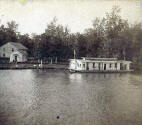 |
|
Quarantine Station |
|
|
|
|
|
 |
 |
The only people who went out were the collectors of the dead. With horse and wagon,
they shouted "Bring out your dead!" And then they loaded
and took all to the cemetery for a hasty burial. They believed
that corpses spread the disease so they tried to get them
in the ground as quickly as possible. They also thought
the disease was spread by bad air. So with temperatures
close to 100, they boarded up their windows and kept
fires burning to ward off the outside air. When people
died, their clothing and beds were dragged into the streets
and burned. Names of
the dead were written in ink in leather-bound ledgers.
There was an average of 200 deaths per day and corpses were
everywhere. Half of those who died were the Irish.
Sixteen Catholic priests and 30 sisters died in their heroic
battle to tend the sick.
|
|
Pick up the dead ... |
Quick burials |
|
|
|
|
|
 |
 |
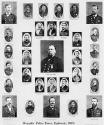 |
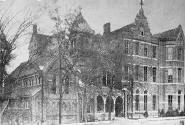 |
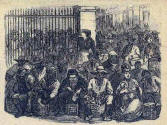 |
|
Pick up the dead |
Camp Williams |
Memphis Police 1878 |
St. Mary's School becomes
Hospital |
Distribution of Food |
|
|
|
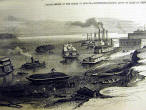 |
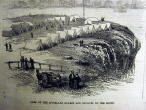 |
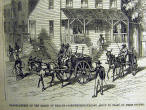 |
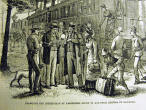 |
|
Board of Health on River |
Camp on the Bluffs |
Disinfectant Wagons |
Examine travelers credentials
|
|
|
|
|
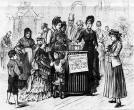 |
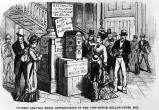 |
Half a million dollars which had been contributed by other states was
expended in the burial of the Memphis dead and for the needed medical
attention during the reign of the plague. By the time
this major epidemic ended, Memphis had lost a total of over
30,000 people to Yellow Fever and the city was financially
broke and desperate. In 1879, the state
legislature revoked Memphis' city charter.
|
|
Collecting Contributions |
Collecting Contributions |
|
|
|
|
|
And once again, the onslaught of Yellow Fever didn't prevent
Memphis from holding its 1878 annual carnival with the
gorgeous pageants. At the time, the 5000 deaths
constituted the most Yellow Fever victims in an inland city -
ever.
=> |
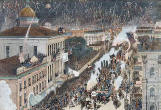 |
|
|
|
|
|
|
There was
a positive effect of the 1878 epidemic: It was the
first time in Memphis history that the black community
served as patrolmen on the police force. Long
thought to be immune to the disease, blacks contracted the fever in
large numbers in 1878 - but only 7% died. Although not
proved, it's now felt that repeated exposure to Yellow Fever over
many generations in West Africa provided many blacks with a higher
resistance to the disease. The African Americans who remained
in Memphis during the epidemics worked tirelessly with the
sick and dying as nurses, cart drivers, coffin makers, and
grave diggers.
They
continued to hold positions in Memphis police, fire, and
other departments long after blacks were barred from
such employment elsewhere. However, by the
end of the century, Memphis joined other southern cities
in denying city employment to the people who had helped
carry them through the devastating epidemic.
|
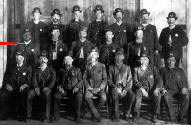 |
|
Memphis
Police 1890 |
|
|
|
|
|
|
|
Some Heroes and
Martrys of the
Yellow Fever Epidemics |
|
|
|
J. M.
Keating
stayed in Memphis during the worst outbreak in 1878. He
was publisher of The Memphis Appeal and wrote a first person
experience of the disease.
Mattie
Stephenson
came from Illinois to Memphis as a nurse during the epidemic
of 1873. The "Heroine of Memphis" died shortly after she
began ministering to the sick and dying. |
 |
 |
| |
J. M. Keating |
Mattie Stephenson |
|
| |
|
|
Sister
Constance
of St. Mary's Episcopal Cathedral stayed in Memphis during one
outbreak, going from house to house to care for the sick.
Sometimes she found abandoned children amid the rotting corpses of
their parents. She contracted the disease and died a few days
later.
Click here for excerpt from her
diary.
Sisters
Thecla, Ruth, Frances
- St. Mary's Episcopal nuns who stayed in the city to care for the
ill. The are all memorialized on the high altar at St. Mary's
Cathedral.
|
 |
 |
| |
Sister Constance |
1879 Book
|
| |
|
Charles Carroll Parsons
was
a priest from St. Mary's
Episcopal Church who died caring for Yellow Fever victims.
Louis Landford Schuyler
was a priest from St. Mary's Episcopal Church who died caring
for Yellow Fever victims. |
 |
 |
| |
Charles Carroll Parsons |
Louis Schuyler |
|
| |
|
The Howard
Association
was
originally created in New Orleans
specifically for the Yellow Fever epidemics to arrange for
volunteer professional nurses
and doctors to care for the poor who had contracted the
disease, and to help pick up the bodies.
Butler P.
Anderson,
president of the Howard Association in 1878 was one of the
first to die after contracting the fever in Grenada, Mississippi where he
had gone to nurse the sick. His wife also died shortly after
returning from his burial.
|
 |
 |
| |
Howard
Association |
Butler Anderson
|
|
|
|
|
|
Dr.John Erskin
was a member of the Howard Association. He was one of
the 110 doctors who tended the sick and dying in 1878.
And he was one of the 33 doctors who died from the disease.
Rabbi Max Samfield
was a member of the Howard Association. He remained in
the city throughout the 1873 and 1878 epidemics and
administered to the sick and buried the dead of all races and
religions. |
 |
 |
| |
John Erskin |
Max Samfield |
|
|
|
|
Dr
R. H. Tate
-
recruited by the Howard Association, the first African
American to practice in Memphis. While helping with the
1878 epidemic he contracted the disease and died within three
weeks.
Annie
Cook
was a Memphis Madam who stayed in the city during the
Yellow Fever epidemic, turned her brothel into a hospital and
took care of the sick. She became known as "Mary
Magdalene of Memphis" after she succumbed to the disease. |
 |
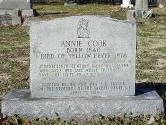 |
| |
R. H. Tate |
Annie Cook |
|
|
|
|
Dr. William Armstrong made house calls
around the clock to care for
the ill during the 1873 Yellow Fever epidemic and again during
the 1878 epidemic until he contracted the virus and died.
Father Joseph Kelly
of St. Peter's Parish became known as "Father of the
Orphans" and "selfless caregiver among victims of Yellow Fever
epidemics". During the 1873-1878 epidemics, he evacuated
all the orphans. |
 |
 |
| |
Dr. Will Armstrong |
Fr. Joseph Kelly |
|
|
|
|
|
|
Yellow Fever Burials:
During the outbreaks of Yellow Fever there were over 5,000
fatalities in the city. Some 2500 of the Memphis victims are buried
in four public lots at Elmwood; among them are doctors, ministers,
nuns, and even prostitutes who died tending to the sick. The four mass
burial areas are referred to as "No Man's Land". There is a plaque
identifying the area.
|
|
|
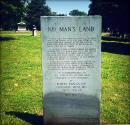 |
 |
 |
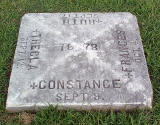 |
 |
 |
|
No Man's Land |
Madam Sutton |
Mattie Stephenson |
St. Mary's Nuns |
Parsons |
Schuyler |
|
|
|
|
|
 |
 |
 |
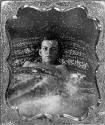 |
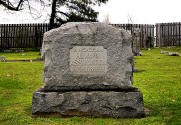 |
|
Eugene Magevny |
Jeff Davis, Jr |
Mrs. Butler Anderson |
McKiven and the Poor |
Howard Association Memorial
|
|
|
|
|
|
|
|
|
Memphis Cleans
Up... |
|
|
|
A major
positive side effect came about after the 1879 epidemic, as
Memphis leaders embarked on ambitious sanitation reform.
Strict sanitation laws were finally passed outlawing open
privies. Regular trash collection was instituted, in
addition to clearing away all the garbage that had accumulated
since the 1878 epidemic due to lack of funds to remove it.
The decaying wooden paving blocks were torn up and gravel
mixed with limestone roads were laid. The centerpiece of
the sanitary reforms was a revolutionary sewer system designed
by George Waring of New York. He used an unprecedented design which
separated the sanitary sewer system from the storm sewers.
It was the design that made Memphis the envy of others and was
to revolutionize the design of sewer systems across the
nation. Ironically George Waring died in 1898, after
returning from Cuba where he was modernizing their sewer
system. The cause of death: Yellow Fever. |
|
|
 |
|
George
Waring |
|
|
|
|
|
|
|
|
|
|
|
Almost a
decade after the 1878 epidemic, an artesian aquifer was
discovered under Memphis, which would provide the city with an
abundant supply of clean and safe water. This became one
of the best water sources in the country.
All these reforms and changes immediately benefited the business district and the wealthier
neighborhoods of the city. It would be years before these
innovations would reach the neighborhoods of the poor. The city
simply had no funds.
|
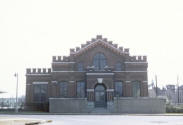 |
|
|
Artesian Pump Station |
|
|
|
|
The
rebirth of Memphis was described by Professor Gerald M. Capers of
Tulane University: "There have been two cities on the fourth
Chickasaw Bluff: the old river town existing prior to 1878,
and the new city that has grown up since 1880".
Some 22 years before Dr. Walter Reed identified the mosquito as the
carrier of yellow fever, Memphis had been transformed to a new
and vibrant city. |
|
|
|
|
|
|
|
"Yellow Fever is
transmitted by the bite of an infected Mosquito..." |
|
|
 |
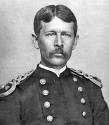 |
Dr. Carlos Findlay,
Cuban doctor, first proposed in 1880 that mosquitoes might
carry the Yellow Fever virus. This, of course was met
with much skepticism.
Walter Reed,
U.S. Army pathologist and bacteriologist would later lead the experiments that
proved Yellow Fever is transmitted by the bite of an infected mosquito.
The Walter Reed Hospital in Washington D.C. is named in his honor.
During most of the 19th century it was widely believed that Yellow
Fever was spread by articles of bedding and clothing of the
victims. In 1900 a small camp was established and controlled
experiments were performed on volunteers. Reed proved that an
attack of Yellow Fever was caused by the bite of an infected
mosquito and that a house became infected only by the presence of
these infected mosquitoes and not by clothing and/or bedding. |
|
Carolos Findlay |
Walter Reed |
|
|
|
|
|
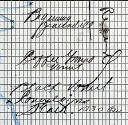 |
 |
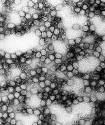 |
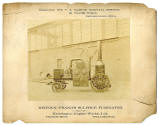 |
 |
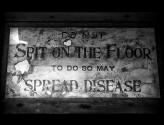 |
|
Symptoms |
Studies |
Yellow Fever |
Sulphur Fumigator |
Posters |
Habits |
|
|
|
|
|
|
|
|
City Beautiful
Campaign's
|
|
|
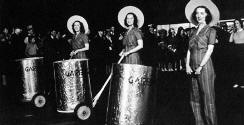 |
<
Memphis created the "Clean Up, Paint Up, Fix Up" campaign in 1941.
The program went National.
Memphis has been a five-time winner of the Nation's
Cleanest City award, from 1948 - 1952, and again in 1983.
It was the "cleanest Tennessee city" from 1940 to 1946.
> |
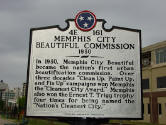 |
|
Clean up ! Paint up !
Fix up ! |
|
City Beautiful Marker |
|
|
|
|
|
|
Martyr's Park |
|
|
|
|
 |
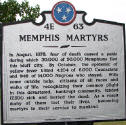 |
Located on a bluff near the Memphis bridge, Martyr's Park opened
in 1972. It's dedicated to those who did not flee from
the yellow fever epidemic in 1878, who stayed to help those
who were infected, and to bury the dead. Almost 80
percent of those who stayed caught the fever and one-quarter
of them perished. The centerpiece of the park is the sculpture
by Harris Sorrelle. |
|
Sorrelle
Sculpture |
Marker |
|
|
|
|
|
|
|
Today,
Yellow Fever has not been eradicated but it has been greatly
reduced by routine childhood vaccinations in endemic
countries. Cases in the U. S. are now very rare.
A Harvard scientist,
Max Thieler
developed the most effective vaccine against Yellow fever.
It immunized U. S. soldiers during World War I and became the
world standard. This achievement won him the Nobel Prize
in Medicine in 1951. |
 |
| |
Max Thieler |
|
|
|
|
|
|
|
|
|
Credits |
|
|
The
Historic-Memphis website does not intentionally post copyrighted
photos and material without permission or credit.
On
occasion a "non-credited" photo might possibly be posted because we
were unable to find a name to give credit. Because of the nature of
our non-commercial, non-profit, educational website, we strongly
believe that these photos would be considered "Fair Use. We have
certainly made no monetary gain, although those using this website
for historic or Genealogy research have certainly profited. If by
chance,
we have posted your copyrighted photo, please contact us, and we'll
remove it immediately, or we'll add your credit if that's your
choice. In the past, we have found that many photographers
volunteer to have their works included on these pages and we'll
also do that if you contact us with a photo that fits a particular
page.
|
|
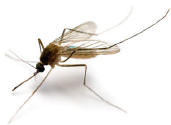 |
|
|
|
|
The "Historic-Memphis" website would like to acknowledge and thank the
following for their contributions which helped make this website
possible: Memphis
Public Library, Memphis University Library, Memphis Law Library,
Memphis Commercial Appeal, Memphis Press Scimitar, Shelby County
Register of Deeds, Memphis City Schools, Memphis Business Men's
Club, Memphis Chamber of Commerce, Memphis City Park Commission,
Memphis Film Commision, Carnival Memphis, Memphis Historical
Railroad Page, Memphis Heritage Inc, Beale Street Historic District,
Cobblestone Historic District, Memphis Historic Districts, Vance
Lauderdale Family Archives, Tennessee State Archives, Library of
Congress, Kemmons Wilson Family, Richard S. Brashier, Lee Askew,
George Whitworth, Woody Savage and many individuals whose assistance is
acknowledged on the pages of their contributions. Special
thanks to Memphis Realtor, Joe Spake, for giving us carte blanche
access to his outstanding collection of contemporary Memphis photos.
We do not have high definition copies of the photos on these
pages. If anyone wishes to secure high definition photos,
you'll have to contact the photographer or the collector.
(To avoid any possibility of contributing to SPAM, we do not
maintain a file of email addresses for anyone who contacts us). |
|
|
|
|
|
|
|
|
|
|
|
|
|
|
|
|
|
|
|
|
| |
|
|